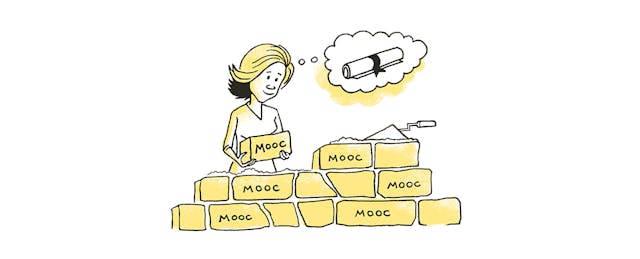In the past year or so there's been a flurry of announcements from the big MOOC providers involving new degree programs based around their online courses. Earlier this year, for instance, Coursera announced six new degrees, including the first-ever MOOC-based Bachelors.
So far, ten universities have announced MOOC-based online degrees, and together they offer a total of 25 different degrees. Right now, more than 9,000 students are enrolled in a MOOC-based online degree, and more than a thousand have already graduated.
I started Class Central at the end of 2011 while taking a free online course from Stanford on AI—even before people started calling these courses MOOCs—and have been following the space ever since. Having been involved with MOOCs since the beginning, this recent wave of announcements reminds me of 2012, the year when MOOCs rose to prominence.
A steady stream of articles heralded MOOCs as the disruptor of higher education. Every month saw a new university partnership or funding round, all feeding into the general feeling that something big was happening. The hype culminated with The New York Times calling 2012 the “year of MOOCs,” a term that nobody had even heard of just a few months prior.
Though the media spotlight no longer shines on MOOC providers, the recent spate of online degree announcements and the resources being spent by MOOC providers and universities alike is giving me a feeling of deja vu. That’s because the major MOOC platforms are all jumping on the bandwagon, announcing partnership after partnership and degree after degree.
Just as in the first wave of MOOC hype, all the MOOC providers and universities are throwing a tremendous amount of resources behind what is essentially an unproven business model.
This isn’t to say that the MOOC platforms’ first forays into online degrees haven’t been successful. Quite the opposite. The first online degrees by Coursera, Udacity and edX have done well, with combined potential revenue of over $80-million based on numbers of currently enrolled students.
The reason I believe we are witnessing a second round of MOOC hype is because the model is still unproven at this point. It is still too early to tell whether the market will support so many MOOC-based degrees, and whether these programs can be sustained at price points so much lower than traditional online or on-campus degrees.
At the same time, I can understand why providers are so enthusiastic about MOOC-based degrees. While the media and the general public haven’t mustered the same level of excitement for MOOC-based online degrees as they did for the original free courses, the MOOC platforms may have found a market they can actually disrupt.
The MOOC providers didn’t bring about the end of higher education as we knew it, but they did stumble upon a highly-effective marketing funnel with the potential to change the way universities put programs online. This niche is known in higher education as online program management (OPM), and providers who work in this space offer solutions to help universities put their programs online. Now, the MOOC providers are poised to make a dent in the highly-lucrative OPM market.
Many courses that are part of an online degree are offered for free, enrolling tens of thousands (if not hundreds of thousands) of students around the world. This large user base gives MOOC-based degrees a marketing advantage over traditional online degree programs. For traditional online degree programs, the cost to acquire a single paying student can reach several thousand dollars. That’s higher than the tuition for certain MOOC-based online degrees.
What makes MOOCs a great marketing channel is also what makes them useful to the many millions of people around the world in need of education, not just those who can afford a multi-thousand dollar degree. Personally, I am hopeful that more of these new MOOC-based degree programs will follow the model of the iMBA (from the University of Illinois Urbana-Champaign on Coursera) or the $7,000 master’s degree in Computer Science by Georgia Tech and Udacity, which offers a majority of its degree content for free to anyone who wants to access it. This would greatly increase the depth of free content available online and could potentially increase the credibility of the entire MOOC space.
It’s too early to tell whether the hype is warranted this time. But if the MOOC platform companies are right, they may have landed on a model that lets them have their cake while free users get to eat it too.


